

20th August 2025 (20 Topics)
Mains Issues
Context:
Despite the launch of POSHAN Abhiyaan (2018) with a target to reduce stunting among children by 2% points annually, India’s stunting rate remains at 37% in 2025, almost unchanged from 38.4% in 2016.
Stunting in India: Current Status
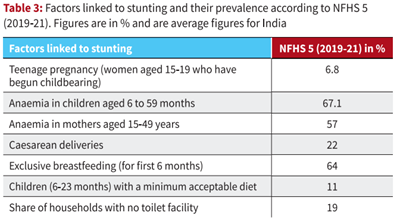
- Definition: A child too short for age due to chronic/recurrent malnutrition.
- Target (POSHAN Abhiyaan): Reduce stunting to 25% by 2022.
- Current Reality (2025): Stunting at 37% ? barely 1% decline since 2016.
- Implication: Deep systemic issues in maternal and child health.
Determinants of Stunting
- Maternal Health and Teenage Pregnancy
- Nearly 7% of women (15–19 yrs) had begun childbearing (NFHS-5, 2019-21).
- Teenage mothers more likely to give birth to underweight children.
- Adolescent bodies biologically unprepared for healthy pregnancy.
- Maternal Education
- 46% of children of uneducated mothers stunted vs 26% for educated mothers (12+ years).
- Education improves antenatal care access, nutrition practices, and delays early pregnancies.
- Mode of Delivery & Breastfeeding
- C-sections increased from 9% (2005-06) ? 22% (2021).
- Delayed breastfeeding, loss of colostrum.
- Exclusive breastfeeding till 6 months only 64% nationally; sharp class disparities.
- Nutrition Quality
- Diet dominated by carbohydrates; protein and micronutrient deficiency widespread.
- Only 11% of children (6–23 months) meet minimum acceptable diet standards.
- Eggs introduced in some Anganwadi meals but access remains limited.
- Anaemia
- 57% of women (15–49 yrs)
- 67% of children <5 yrsanaemic (NFHS-5).
- Sanitation and Water Quality
- 19% households practice open defecation (2019-21).
- Unsafe water ? frequent infections ? poor nutrient absorption.
- Malnutrition–infection vicious cycle worsens stunting.
Consequences of Stunting
- Long-term correlation with:
- Poverty and low productivity.
- Weaker cognitive skills, poor educational outcomes.
- Intergenerational cycle of deprivation.
Way Forward
- Strengthen Maternal and Child Health
- Focus on reducing adolescent pregnancies through stricter enforcement of Prohibition of Child Marriage Act, 2006.
- Improve maternal nutrition through POSHAN 2.0 supplementation and antenatal care.
- Enhance Dietary Diversity
- Expand egg and protein inclusion in Anganwadi and mid-day meals.
- Promote locally available nutrient-rich foods (millets, pulses, green vegetables).
- Education and Awareness
- Promote female education and skill development to delay marriage and childbearing.
- Nutrition literacy programs at community level.
- Improve Sanitation and Water Access
- Strengthen Swachh Bharat Mission (SBM) and Jal Jeevan Mission.
- Behavioural change campaigns on hygiene and safe drinking water.
- Institutional Mechanisms
- Ensure real-time monitoring through POSHAN Tracker.
- Improve coordination between Health, Education, WCD, and Sanitation ministries.
- Shift focus from calorie security to nutrition security.


Mains Issues
Context:
In August 2025, the U.S. announced 50% tariffs on Indian imports, including a 25% penalty for India’s oil purchases from Russia.
Background: U.S. Tariff Measures
- Tariffs = taxes levied on imports; traditionally low in the U.S. (2–3% till 2024).
- April 2025: steep tariff hikes by the U.S. under President Trump.
- India targeted with 50% tariffs, higher than Vietnam or Bangladesh (?12%).
- Contrast: China, initially hit with 145% tariffs, later negotiated reduction to 30%.
Implications for India
- Economic Impact
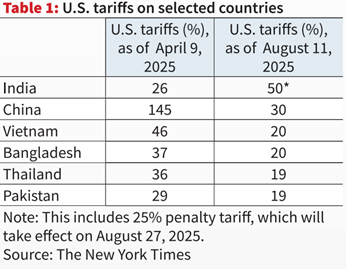
- Loss of competitiveness: A $10 Indian shirt becomes $15 in the U.S., compared to $12 from Vietnam/Bangladesh.
- Export loss risk: U.S. is India’s largest export destination (textiles, pharma, IT).
- Widening trade deficit due to reduced dollar inflows.
- Employment and income loss in export-oriented sectors.
- Agricultural Market Pressure
- S. demands access for its dairy and agricultural products in exchange for tariff concessions.
- Potential harm to Indian farmers and dairy cooperatives.
Nature of China’s Influence
- Competitive edge: scale, infrastructure, technology.
- China’s global share:
- 36.3% in textiles & clothing,
- 24.9% in machinery/electrical equipment.
- India: 4.4% and 0.9% respectively.
- S.–China thaw due to China’s strategic role in supply chains (rare earths, electronics).
- Risk: tariff wars may divert global investments away from India.
Structural Challenges for India
- Over-reliance on low wages for competitiveness.
- Weakness in R&D and high-value sectors.
- Export base narrow compared to China’s diversified portfolio.
Shift in Global Demand Dynamics
- Western demand weakening due to ageing populations and inequality.
- Rising protectionism = less open markets.
- Future growth must be home-market-driven, not only export-led.
Role of India’s Youth
- India: world’s youngest workforce; 120 million youth (15–29 years) in education = equivalent to Japan’s population.
- Indian diaspora in the U.S.: 3.2 million (2023), disproportionately successful in tech, education, and innovation.
- Potential: shift from low-cost labour to knowledge and technology-based economy.
Way Forward
- Immediate Policy Options for India
- Diplomatic negotiations with the U.S. to seek tariff relaxation.
- Diversify export destinations: ASEAN, EU, Africa, West Asia.
- Countermeasures: calibrated tariffs on select U.S. products (without escalating trade war).
- Medium- to Long-term Strategies
- Enhance competitiveness: strengthen infrastructure, logistics, and technology adoption.
- Invest in R&D: pharmaceuticals, electronics, renewable energy.
- Protect domestic agriculture: resist U.S. dairy pressure by supporting cooperatives and nutrition-based domestic policies.
- Promote domestic demand: rising wages, job creation, and welfare spending (health, education).
- Skill development: harness youth bulge to move up global value chains.
- Leverage diaspora networks for technology and investment flows.
- Strategic Outlook
- India must avoid dependence on low-wage labour exports.
- Develop into a knowledge-driven, high-value economy with strong domestic demand.
- Youth and innovation must serve as strategic shields against global trade turbulence.

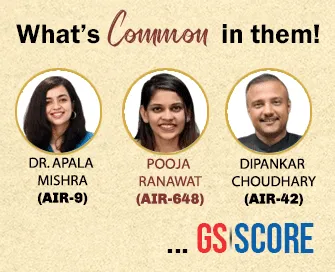
Mains Issues
Context:
India surpassed its COP26 commitment, achieving over 50% non-fossil fuel installed power capacity five years ahead of the 2030 target.
India’s Fast-Track Green Transition and Renewable Energy Leadership
Surpassing Renewable Targets
- India achieved 50.07% of installed power capacity from non-fossil fuels (242.8GW out of 484.82GW) by June 2025, surpassing the COP26 target five years early.
Global Renewable Rankings
- 4th in Renewable Energy Installed Capacity
- 4th in Wind Power Capacity
- 3rd in Solar Power Capacity (IRENA, 2025)
Solar Power Output
- India produced 1,08,494GWh of solar energy in 2025, overtaking Japan to become the third-largest solar power producer.
Expansion of Solar and Renewables
- Solar Capacity Growth
- Total solar capacity:02GW (as of July 2025); marked by a 4,000% increase in the last decade.
- Composition:99GW (ground?mounted), 19.88GW (rooftop), 3.06GW (hybrid), 5.09GW (off?grid).
- Geographic Potential
- India's solar potential: 748GW; high-potential states include Rajasthan, J&K, Maharashtra, Madhya Pradesh, Andhra Pradesh, and Gujarat.
- Record Surge in Installation
- Renewable energy installed capacity:99GW in 2025, up from 76.37GW in 2014.
Manufacturing and Domestic Industry Boost
- Solar Manufacturing Capacities
- Module manufacturing grew from 38GW (March 2024) to 74GW (March 2025).
- PV cell manufacturing rose from 9GW to 25GW in the same period.
- Ingot-wafer manufacturing initiated (2GW).
- Policy Support
- Mandatory Indian-made panels for government-backed projects
- Basic Customs Duty (BCD) on imports since April 2022 to incentivize local manufacturing.
Flagship Schemes & Policy Initiatives
- PM Surya Ghar: Muft Bijli Yojana
- Budget: ?75,021 crore; targets 1 crore households with up to 300 units/month free electricity through rooftop solar installation.
- PM-KUSUM
- Subsidies (30-50%) for farmers installing solar pumps; support for decentralized solar plants up to 2MW; builds farmer energy security and additional income.
- Solar Parks Scheme
- Target:40GW by March 2026.
- Progress: 53 parks (39,323MW approved, 13,896MW operational in 26 parks).
- PM JANMAN: Tribal Electrification
- ?515 crore allocated to electrify 1 lakh un-electrified households in PVTG areas across 18 states.
- Floating Solar Projects and Agrivoltaics
- Projects such as Omkareshwar Floating Solar Park and agrivoltaics demonstration sites exhibit innovation in land and water use.
Green Hydrogen and Alternative Energies
- National Green Hydrogen Mission
- By 2030:5 million tonnes annual production, ?8 lakh crore investment, 6 lakh jobs, significant fossil-fuel import reductions.
- International Collaboration
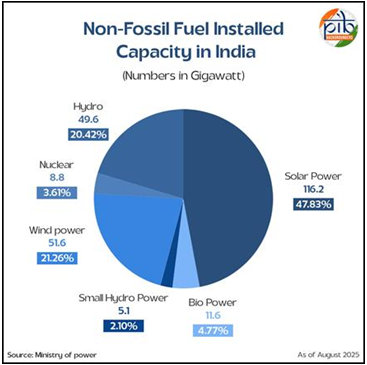
- International Solar Alliance (ISA) and One Sun One World One Grid (OSOWOG): multilateral efforts to enhance global solar connectivity and technology sharing.
Renewable Sector: Current Overview and Additional Contributions
- Ethanol Blending
- Ethanol blending in petrol reached 17.98% by Feb 2025; target of 20% by 2025–26.
Policy Roadmap and Future Outlook
- Government Priorities for 2030 Targets
- Long-term Contracts: Investor confidence
- Grid Strengthening: Smart grids, storage
- Make in India: Further localization of supply chains
- Smart Land Use: Floating and farm-based solar
- Easy Financing:Enabling capital flow for RE projects
- Green Jobs and Economy
- Job creation and investment—solar and green hydrogen sectors highlighted for potential to generate millions of jobs by 2030.
- Net Zero by 2070
- India remains committed to achieving net-zero emissions by 2070, with a 45% reduction in carbon intensity by 2030 (over 2005 levels) in line with its Paris Agreement NDC.
Challenges Ahead:
- Energy Storage:Need for rapid scaling of energy storage to ensure grid stability as RE share rises
- Manufacturing Ecosystem:Upgradation in solar PV technology, expanded supply chains
- Skilling and R&D:Address skilled workforce requirements for new technologies (incl. hydrogen, storage)
- Financing:Mobilisation of low-cost, large-scale finance for both grid and off-grid RE
Way Forward:
- Accelerate deployment of grid-scale storage and advanced forecasting systems
- Strengthen policies for domestic R&D in RE and hydrogen
- Expand mini-grid and decentralized renewable systems for last-mile access
- Maintain policy certainty and invest in capacity building for implementing agencies
- Explore regional and cross-border RE trade through platforms such as ISA and OSOWOG


Prelims Articles
Context:
Rosinka Chaudhuri’s recent work India’s First Radicals: Young Bengal and the British Empire revisits the radical ideas of Henry Derozio and his students in 19th-century Bengal.
Henry Derozio and Hindu College
- Henry Louis Vivian Derozio (1809–1831), an Anglo-Indian poet and radical thinker, was appointed lecturer at Hindu College, Calcutta in 1826.
- He inspired students (later known as the Derozians or Young Bengal) to question orthodoxy, promote rational thought, and advocate liberty and equality.
- He founded the Academic Association, a debating society that discussed social reform and enlightenment ideas.
Young Bengal Movement (1820s–1840s)
- Emphasized freedom of thought, equality, and social reform, often opposing caste restrictions, idolatry, and conservative traditions.
- Members included RadhanathSikdar, Krishnamohan Banerjee, Peary Chand Mitra, Rasik Krishna Mallick, etc.
- Their radicalism led to criticism from orthodox society, and Derozio was dismissed from Hindu College in 1831 on charges of promoting atheism.
Political Awakening
- With British abolitionist George Thompson’s support, the Bengal British India Society (1843) was founded, regarded as one of the earliest political associations in India.
- Its objectives: securing welfare, extending rights, and advancing interests of all classes of Indians.
RadhanathSikdar’s Contribution
- A Derozian, mathematician, and surveyor in the Great Trigonometrical Survey of India (GTSI).
- First calculated that Peak XV (later Mount Everest) was the highest mountain in the world.
- His role was later overshadowed, and official credit went to Andrew Waugh.
Legacy and Limitations
- Though short-lived, the Young Bengal Movement laid the intellectual foundation for later reform movements in Bengal.
- Their emphasis on inclusive nationalism, rationality, and equality resonated with later leaders like Gandhi and Nehru.
- However, their impact on society was limited due to elitist reach (confined mostly to urban educated youth) and lack of practical reform initiatives.


Prelims Articles
Context:
Mumbai has witnessed extremely heavy rainfall (200 mm+ in 24 hours at some stations) between August 16–19, due to combined synoptic weather systems amplifying the southwest monsoon.
Synoptic systems:
- Synoptic systems are large-scale weather phenomena that influence rainfall patterns during the monsoon season in India. They are the immediate drivers of daily and seasonal rainfall distribution.
- These includes
- Low-Pressure Systems
- Types: Depressions, cyclonic circulations, low-pressure areas.
- Origin: Mostly over the Bay of Bengal (less frequent over the Arabian Sea).
- Role: They travel inland, carrying moisture and triggering widespread rainfall across central and north India.
- Depressions: The most important rain-bearing system; responsible for major share of monsoon rains.
- Monsoon Trough
- An elongated low-pressure zone extending from northwest India to the Bay of Bengal.
- It oscillates north-south during the season.
- Northward shift ? heavy rains over Himalayas & NE India.
- Southward shift ? heavy rains over Gangetic plains, Central & Peninsular India.
- Break monsoon condition linked to weakening of this trough.
- Troughs & Cyclonic Vortices
- East–West Troughs: Promote sustained cloud formation & prolonged rain.
- Cyclonic Vortices: Small-scale circular systems, short-lived but can cause localised intense rainfall.
- Off-shore Trough
- Runs parallel to the West Coast of India during active monsoon phases.
- Responsible for heavy rains along Konkan, Goa, Karnataka, and Kerala coast.
- Western Disturbances (WDs)
- Extra-tropical weather systems originating in the Mediterranean region.
- Move eastwards and cause rainfall in NW India during winter & early monsoon season.
- In summer, they interact with monsoon currents, influencing rainfall variability.
- Easterly Waves
- Formed in the Bay of Bengal and move westwards.
- Influence east coast rainfall during monsoon and Tamil Nadu rainfall in NE monsoon season.
- Low-Pressure Systems


Prelims Articles
Context:
The Ministry of Social Justice and Empowerment reported that 18 Garima Grehs are functional across 15 States/UTs, with approval for 3 new Garima Grehs in FY 2025–26.
About Garima Greh:
- A shelter home initiative for transgender persons supported by the Department of Social Justice & Empowerment (DoSJE).
- Provides food, shelter, medical care, counselling, yoga, meditation, and recreational facilities.
- Focuses on capacity-building, skill development, and livelihood training for mainstreaming transgender persons.
- Safeguards rights of transgender persons and protects them from atrocities and discrimination.
Current Status (2025):
- 18 Garima Grehs operational in 15 States/UTs.
- 3 new Garima Grehs approved for FY 2025–26.
- 429 residents currently staying in these shelters.
- Proposals forwarded to 14 States/UTs for further expansion.
- ?8.25 crore released and utilised under the scheme.
Associated Scheme:
- Garima Grehs function under the Support for Marginalised Individuals for Livelihood and Enterprise (SMILE) Scheme.
- SMILE Scheme provides comprehensive rehabilitation, welfare, and livelihood support for marginalized groups, including transgender persons and beggars.


Prelims Articles
Context:
The Ministry of Tribal Affairs has launched the Adi Karmayogi Abhiyan, envisaged as the world’s largest tribal grassroots leadership programme to empower tribal communities and strengthen responsive governance.
About the Programme:
- Launched in August 2025 by the Ministry of Tribal Affairs.
- Guided by principles of Sewa (Service), Sankalp (Resolve), and Samarpan (Dedication) under the vision of “SabkaSaath, Sabka Vikas, SabkaPrayas, Sabka Vishwas.”
- Forms part of Janjatiya Gaurav Varsh and contributes to the vision of Viksit Bharat @ 2047.
Key Objectives:
- Promote responsive, people-centric governance at grassroots levels.
- Conduct Governance Lab Workshops/Process Labs from state to village levels for capacity building of master trainers.
- Formulate the “1 Lakh Tribal Villages-Vision 2030” with co-created development and investment plans.
- Build a network of 20 lakh tribal change leaders across 550 districts and 30 States/UTs.
Important Features:
- Adi Sewa Kendra: To be established in all tribal villages, where officers and community members spend time for problem-solving, mentoring, and governance initiatives.
- Tribal Village Action Plan: Villagers and officers co-create development blueprints aligned with SDGs and inclusive growth.
- Saturation of schemes: Ensures universal access to central and state flagship welfare schemes.
Participation and Volunteers:
- Adi Sahyogi: Professionals like teachers and doctors mentoring communities.
- Adi Saathi: SHGs, NRLM members, youth, elders and local leaders supporting outreach.
- Community Leadership Training: Targeted at tribal youth, women, and local leaders.
|
Associated Flagship Tribal Initiatives:
|


Prelims Articles
Context:
The Union Cabinet has approved the development of a Greenfield Airport at Kota-Bundi, Rajasthan, at an estimated cost of ?1507 crore.
Greenfield Airport:
- A Greenfield Airport is a new aviation facility built entirely from scratch on previously undeveloped land.
- Unlike Brownfield projects, it does not involve redevelopment or demolition of existing structures.
Key Characteristics
- Built on vacant/undeveloped land (e.g., grasslands, meadows).
- Designed with modern infrastructure and eco-friendly features.
- No demolition or legacy constraints.
Greenfield Airportin India:
- India has approved 21 greenfield airport projects, with 12 already operational.
- These operational airports include Durgapur, Shirdi, Kannur, Pakyong, Kalaburagi, Orvakal (Kurnool), Sindhudurg, Kushinagar, Itanagar, Mopa, Shivamogga, and Rajkot.
- Additionally, development is progressing rapidly on the Noida (Jewar) and Navi Mumbai International Airports.
Advantages
- Faster Construction: No time spent demolishing old structures.
- Connectivity: Enhances regional, national, and international air travel; reduces congestion at existing airports.
- Economic Growth: Promotes trade, tourism, investment, and employment.
- Environmental Edge: Allows integration of renewable energy, green buildings, and sustainable design.
|
Greenfield Airports (GFA) Policy, 2008
|


Prelims Articles
Context:
The Government has launched multiple campaigns and programs to promote the use of Nano Urea and Nano DAP across India.
Nano Fertilizers:- Nano Urea and Nano DAP are liquid fertilizers developed using nanotechnology.
- They are applied mainly through foliar spray, reducing soil burden and fertilizer wastage.
Institutional Promotion:
- ICAR–Indian Institute of Soil Science (Bhopal) recently organized a national campaign on Efficient and Balanced Use of Fertilizers (including Nano Fertilizers).
- Department of Fertilizers (DoF) included Nano Fertilizers in the monthly supply plan and launched adoption campaigns with fertilizer companies.
Distribution and Awareness:
- Made available at Pradhan Mantri KisanSamridhiKendras (PMKSKs).
- Awareness created through field demonstrations, farmer meetings, webinars, KisanSammelans, and films in regional languages.
Technological Support:
- Promoted use of Kisan Drones and battery-operated sprayers for foliar application.
- Training and custom hiring services facilitated through Village Level Entrepreneurs (VLEs).
Nationwide Adoption Drives:
- Maha Abhiyan for Nano DAP adoption in all 15 agro-climatic zones of India.
- Field-level demonstrations of Nano Urea Plus launched across 100 districts.
Significance:
- Enhances fertilizer efficiency and reduces dependence on conventional urea/DAP.
- Contributes to sustainable agriculture and lowers the fertilizer subsidy burden.


Prelims Articles
Context:
The Centre has implemented the “Anna-Chakra” Supply Chain Optimisation Tool under the Public Distribution System (PDS) in 30 out of 31 States/UTs, with estimated annual savings of ?250 crore.
About Anna-Chakra Tool:
- A digital supply chain optimisation tool designed for the Public Distribution System (PDS).
- Focuses on route optimisation for foodgrain transportation, reducing logistical costs.
- Implemented in 30 States/UTs; not yet implemented in Manipur.
Economic Significance:
- Estimated annual savings of ?250 crore in transportation costs.
- Enhances efficiency of foodgrain movement from FCI depots to ration shops.
Environmental Benefits:
- Optimised transportation routes contribute to lower CO? emissions.
- Aligns with India’s climate change commitments under international frameworks.
Public Distribution System (PDS) Linkage:
- PDS operates under the National Food Security Act (NFSA), 2013, covering ~81 crore beneficiaries.
- Strengthened through digital initiatives such as One Nation One Ration Card (ONORC), end-to-end computerisation, and now Anna-Chakra tool.


Prelims Articles
Context:
As per National Account Statistics 2025, the textile and apparel industry contributed 2% to India’s GDP and 11% to manufacturing GVA during the last three years.
Economic Importance:
- Textile and Apparel Industry contributes ~2% to GDP and ~11% to manufacturing GVA (last 3 years).
- Provides direct employment to over 45 million people, making it one of the largest employers after agriculture.
- Plays a key role in exports, women empowerment, and cultural heritage promotion.
Government Initiatives for Textile Sector:
- PM-MITRA Parks Scheme
- Approved 7 Mega Textile Parks with integrated world-class infrastructure.
- Aim: attract investment, provide plug-and-play facilities, and boost employment.
- PLI Scheme for Textiles (launched 2021):
- Targets Manmade Fibre (MMF) fabrics, MMF apparel, and technical textiles.
- Encourages large-scale manufacturing and global competitiveness.
- National Technical Textiles Mission (2020–24):
- Objectives:
- Research, innovation and development
- Promotion and market development
- Education and skilling
- Export promotion
- Aim: Position India as a global leader in Technical Textiles.
- Objectives:
- Skill Development (Samarth, NHDP):
- Samarth (Scheme for Capacity Building in Textile Sector) – enhances skill development.
- NHDP (National Handloom Development Programme) – supports weavers and handloom clusters.


Prelims Articles
Context:
The Department of Fisheries has operationalisedincentives for aquaculture insurance under the Pradhan Mantri MatsyaKisanSamridhiSah-Yojana (PM-MKSSY) through the National Fisheries Digital Platform (NFDP).
Scheme Overview:
- PM-MKSSY is a Central Sector Sub-scheme under Pradhan Mantri MatsyaSampada Yojana (PMMSY).
- Duration:2023-24 to 2026-27; Outlay: ?6000 crore.
- Focus:Formalisation and digitalisation of India’s fisheries and aquaculture sector.
National Fisheries Digital Platform (NFDP):
- Launched on 11 September 2024.
- Provides digital identities for fishers and farmers.
- Serves as a one-stop solution for credit, traceability, training, insurance, and cooperative strengthening.
Aquaculture Insurance Incentives (Component 1-B):
- Farmers get 40% incentive on insurance premium with ceilings:
- ?25,000/ha (up to 4 ha WSA) – Max ?1 lakh/farmer.
- ?1 lakh/farmer for intensive systems (RAS, bio-floc, raceways, cage culture).
- SC/ST and women beneficiaries get an additional 10% incentive.
- Current Status: 684 applications received, 29 farmers applied for incentives, 8 availed benefits.
- 85 awareness camps conducted across states.
Significance:
- Encourages risk mitigation in aquaculture.
- Promotes adoption of modern intensive systems.
- Enhances resilience and sustainability of India’s fisheries sector.


Prelims Articles
Context:
The West Bengal Forest Department’s 2025 survey has recorded a population increase of saltwater crocodiles, particularly hatchlings, in the Sundarbans Biosphere Reserve (SBR).
About:
- Largest living reptile and apex predator of estuarine ecosystems.
- Described as a hypercarnivorous apex predator that maintains aquatic ecosystem health by feeding on carcasses.
Geographical Distribution in India:
- Found in Sundarbans (West Bengal), mangroves and rivers of Odisha, and Andaman & Nicobar Islands.
- Major conservation facility: Bhagabatpur Crocodile Project (South 24 Parganas, West Bengal, established 1976).
Population Status (2025 Study):
- Estimated between 220 – 242 individuals (213 direct sightings).
- Significant rise from 2024, when the maximum estimate was 234.
- Composition in 2025: 125 adults, 88 juveniles, and 23 hatchlings (vs. only 2 hatchlings in 2024).
- Encounter rate: 18 per km, i.e., one crocodile every 5.5 km of surveyed stretch.
Conservation Aspects:
- Categorized as Vulnerable under the IUCN Red List.
- Listed in Schedule I of the Wildlife Protection Act, 1972 (highest protection).
- Protected under CITES Appendix I (international trade prohibition).
- Conservation aided by GPS mapping, habitat characterization, and breeding programmes.
Difference Between Crocodile, Mugger (Marsh Crocodile) and Gharial:
|
Feature |
Crocodile |
Mugger (Marsh Crocodile) |
Gharial |
|
Snout Shape |
V-shaped, relatively narrow |
Broad, U-shaped |
Very long, thin, elongated |
|
Habitat |
Rivers, estuaries, mangroves, brackish waters (salt tolerance high) |
Freshwater rivers, lakes, reservoirs, marshes |
Major rivers with deep, fast-flowing waters |
|
Geographical Range |
Widely distributed in Africa, Asia, Americas; in India mainly Sundarbans and east coast |
Indian subcontinent: rivers, lakes of central & peninsular India |
Northern India: Chambal, Ganga, Mahanadi, Brahmaputra |
|
Diet |
Carnivorous: fish, birds, mammals, sometimes livestock |
Opportunistic feeder: fish, reptiles, mammals, birds |
Mostly piscivorous (fish-eating specialist) |
|
Salt Glands |
Well-developed; allows survival in saline water |
Poorly developed; restricted to freshwater |
Absent; freshwater only |
|
Conservation Status (IUCN) |
Species-specific (Saltwater Crocodile – Least Concern) |
Vulnerable |
Critically Endangered |
|
Unique Feature |
Can thrive in both fresh & saline waters |
Most widespread crocodilian in India |
Male has bulbous growth (‘ghara’) at snout tip |


Prelims Articles
Context:
Hearings in the Kerala High Court were adjourned after palm civets dirtied the courtroom ceiling and air-conditioning ducts.
Palm Civets
Endemic Species of the Western Ghats
- The brown palm civet is found exclusively in the Western Ghats, a UNESCO World Heritage biodiversity hotspot.
- Its distribution ranges from Castle Rock (Goa-Karnataka border) down to KalakkadMundanthurai Tiger Reserve (Tamil Nadu).
- Being endemic highlights its importance for regional biodiversity conservation and ecosystem stability.
Physical and Unique Features 
- Unlike many civets that have distinctive facial stripes, the brown palm civet has a uniform brown coat with darker shades on the head, legs, and tail.
- A distinctive feature is the reversed hair growth on the nape, a rare trait shared only with the golden palm civet.
- Its nocturnal and arboreal nature makes it elusive and difficult to study in the wild.
Habitat and Ecological Niche
- Prefers tropical montane rainforests of mid-elevation ranges (500–1300 m).
- Adapted to arboreal life, it spends most of its time on trees and is rarely seen on the ground.
- Plays a vital role in maintaining rainforest dynamics by interacting with a wide variety of fruiting trees.
Diet and Seed Dispersal Role
- Its diet is 97% frugivorous, making it one of the few carnivores primarily dependent on fruit.
- Consumes fruits of over 53 plant species, especially native rainforest trees.
- Functions as a key seed disperser, aiding natural forest regeneration and connectivity in fragmented landscapes.
Conservation Status and Protection
- IUCN Red List:Least Concern – due to its relatively wide distribution in the Western Ghats.
- CITES:Appendix III – requires cooperation of other countries to control trade and ensure survival.
- Still vulnerable to deforestation, habitat fragmentation, road kills, and hunting pressures in some areas.
Ecological Significance in the Western Ghats
- Considered a keystone frugivore, crucial for maintaining forest structure.
- By dispersing seeds across large areas, especially in fragmented forests, it contributes to restoring degraded patches.
- Serves as an indicator species for assessing rainforest health and the impact of habitat loss.


Prelims Articles
Context:
A new study (PRX Quantum, July 2024) by Jacob Covey, Igor Pikovski, and Johannes Borregaard proposes using entangled atomic clocks to experimentally probe the interface of quantum mechanics and general relativity.
Background of the Problem
- Quantum mechanics governs the microscopic world, while general relativity describes gravity and spacetime curvature.
- Both theories are successful individually but lack a unified framework, making their reconciliation one of the deepest puzzles in modern physics.
Two Categories of Efforts in Bridging the Gap
- Quantum Gravity Approach: Attempts to quantise gravity itself, using hypothetical particles called gravitons.
- Curved Spacetime Approach: Examines how ordinary quantum systems behave in pre-existing curved spacetime, without invoking speculative new particles.
Spacetime Curvature and Time Dilation
- General relativity shows that massive objects curve spacetime, leading to nonlinear variations in the flow of time.
- Example: Time difference between clocks at varying heights is not uniform across distances, providing direct evidence of curvature.
Proposed Experimental Setup
- Involves a network of three entangled atomic clocks separated by kilometre-scale elevations.
- Uses the W state of quantum entanglement, which is resilient even if one particle is lost.
- Atoms: Ytterbium atoms chosen as qubits, with coherence times of ~50 seconds.
- Detectable shifts: Frequency changes of ~0.02 Hz due to curvature-induced time dilation.
Significance
- Would be the first laboratory probe of spacetime curvature using quantum systems.
- Tests foundational principles of quantum mechanics in curved spacetime: unitarity, linearity, and Born rule.
- Opens possibilities for future precision detectors of dark matter and gravitational waves.
- Marks a shift from only large-scale astronomical observations to controlled laboratory-based quantum-gravity experiments.
Technological Challenges
- Entangled states are fragile and sensitive to decoherence.
- The proposed setup is currently at the frontier of experimental feasibility.
|
Quantum Mechanics (QM)
General Relativity (GR)
|


Prelims Articles
Context:
The 8th National Anubhav Awards were presented in New Delhi, celebrating a decade of the initiative and honouring 15 awardees from 11 ministries, including PSU bank and BHEL officers for the first time.
Background of Initiative:
- Launched in 2015 by the Government of India under the Department of Pension & Pensioners’ Welfare.
- Objective: To record experiences of retiring officials as institutional memory for governance.
- Functions as part of the Anubhav Portal, where officers submit memoirs before superannuation.
Anubhav Awards:
- Recognises selected memoirs highlighting significant contributions during service.
- Encourages transparency, citizen-centric governance, and better human resource management.
- This year marks the 10th anniversary of the initiative.
Key Features of 2025 Awards:
- 15 awardees across 11 ministries/departments, with one-third women awardees.
- For the first time, officers from a Public Sector Bank (SBI) and a Central Public Sector Enterprise (BHEL) were felicitated.
- Over 12,500 memoirs published on the Anubhav Portal so far.

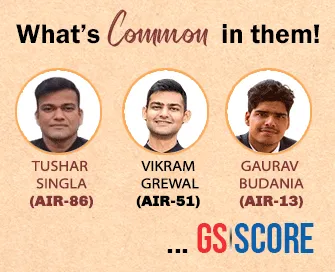
Prelims Articles
Context:
The Government has outlined the criteria and verification process for declaring villages as ODF Plus under Swachh Bharat Mission (Grameen), Phase-II.
ODF Plus Village
- A village that sustains its Open Defecation Free (ODF) status, ensures solid and liquid waste management, and maintains visual cleanliness.
Stages of ODF Plus
- ODF Plus Aspiring: ODF status + Solid Waste Management OR Liquid Waste Management.
- ODF Plus Rising: ODF status + both Solid and Liquid Waste Management.
- ODF Plus Model: ODF status + both SWM & LWM + visual cleanliness (minimal litter, no stagnant water, no plastic dumps) + IEC displays.
Declaration and Verification
- Villages self-declare ODF Plus in Gram Sabha.
- Mandatory third-party verification within 90 days only for ODF Plus Model
- Supervisory verification may be conducted at Aspiring, Rising, and Model levels by Block/District/State officers.
Implementation Framework
- Sanitation is a State subject; Centre provides financial and technical support.
- SBM(G) Phase-II (2020–21 to 2025–26) focuses on:
- Sustaining ODF status.
- Universal coverage with solid & liquid waste management.
- Construction of new toilets for emerging and migrant households.
Significance
- Moves focus beyond mere toilet construction towards sustainability and cleanliness.
- Integrates waste management, community monitoring, and visual cleanliness.
- Strengthens rural sanitation as a continuous and evolving process


Editorials
Context:
Concerns have resurfaced about the credibility and transparency of electoral rolls, with calls for the Election Commission (EC) to return to its uncompromising standards.
Electoral Rolls as the Lifeline of Democracy
- Foundation of Free Elections: Accurate and credible rolls are essential to uphold the principle of “one person, one vote”, ensuring free and fair elections.
- Role of the Election Commission: The EC, backed by Supreme Court judgments, bears the constitutional duty of maintaining the integrity of the electoral process.
- Transparency as a Guiding Principle: Public scrutiny, openness, and citizen participation in verification exercises are vital for electoral trust.
Innovations and Challenges in Roll Management
- SAD Voters Identification: In the 2007 UP elections, the EC innovatively handled “SAD” (Shifted, Absent, Dead) voters by preparing a separate list, preventing disenfranchisement and large-scale disputes.
- Surveys and Verification: Independent studies like those by the Centre for the Study of Developing Societies (CSDS) revealed significant voter roll discrepancies, highlighting the need for rigorous door-to-door verification.
- Transparency in Electoral Practices: Over the years, initiatives such as Ethical Voting (2014), Accessible Elections (2018), and No Voter Left Behind (2019) demonstrated the EC’s efforts toward inclusivity and fairness.
Restoring Trust through Greater Accountability
- Importance of Public Scrutiny: Mechanisms like booth-level officer verification, stakeholder consultation, and structured review processes enhance voter confidence.
- Need for Institutional Independence: Reduced transparency has raised doubts about the EC’s independence; reinforcing autonomy is key to regaining public trust.
- Returning to Best Practices: Restoring uncompromising transparency, ensuring accurate rolls, and publicly verifying each voter’s inclusion is the only way forward.
Practice Question:
“Electoral rolls form the bedrock of free and fair elections in India. Critically evaluate the challenges in maintaining their accuracy and discuss the reforms necessary to restore transparency and public trust in the Election Commission.” (250 words)


Editorials
Context:
The centenary year of M.S. Swaminathan’s birth and the release of his biography “M.S. Swaminathan: The Man who Fed India” highlight his role in India’s Green Revolution and the contemporary lessons for scientific development.
Foundations of the Green Revolution
- Collaboration in Science: Scientific advances are not isolated achievements but the result of cross-fertilisation of ideas and international collaboration, as seen when Swaminathan connected with Norman Borlaug to introduce Mexican wheat varieties.
- Bureaucratic Hurdles: The invitation to Borlaug was delayed for two years due to bureaucratic procedures, showing how administrative red tape can obstruct timely scientific progress.
- Support from Leadership: Political support from leaders like Lal Bahadur Shastri and C. Subramaniam was crucial in securing funds and enabling large-scale trials for new wheat varieties.
Political-Scientific Interface
- Direct Access for Scientists: Swaminathan stressed that politicians must hear scientists directly instead of relying solely on generalist bureaucrats to communicate technical issues.
- Technically Skilled Ministers: Leaders with scientific or technical backgrounds, such as C. Subramaniam, were able to make informed decisions in favour of agricultural reforms.
- Managing Conflicting Opinions: The introduction of new seeds faced opposition from the Finance Ministry, Planning Commission, and political groups, but strong leadership resolved differences and ensured timely adoption.
Contemporary Relevance
- Need for Research Investment: India spends only 0.43% of agricultural GDP on R&D, half of China’s investment, which explains why Indian agricultural institutions lag globally.
- Institutional Autonomy: Improving governance and merit-based recruitment in research institutions is essential for scientific excellence and global competitiveness.
- Sustainability Concerns: Excessive water and fertilizer use during the Green Revolution led to environmental degradation, underlining the need for eco-friendly innovations in the face of climate change.
Practice Question:
“Discuss the relevance of M.S. Swaminathan’s lessons from the Green Revolution in addressing the challenges of agricultural productivity, research governance, and sustainability in contemporary India.” (250 words)


Editorials
The Ministry of Finance released India’s draft Climate Finance Taxonomy for public consultation in May 2025 to guide green investments and prevent greenwashing.
Designing a Review Architecture
- Two-Level Review Mechanism: The taxonomy should adopt both annual reviews for short-term corrections and five-year comprehensive reviews aligned with India’s NDC updates and the global stocktake.
- Annual Review Triggers: Yearly reviews must address implementation gaps, evolving obligations, stakeholder inputs, and policy shifts through structured timelines and mandatory public consultations.
- Five-Year Comprehensive Cycle: Deeper reviews every five years should assess changes in carbon markets, international standards, and domestic sectoral transitions for long-term resilience.
Legal and Substantive Review Parameters
- Legal Coherence: Reviews must align the taxonomy with existing Indian laws (Energy Conservation Act, SEBI norms, Carbon Credit Trading Scheme) and harmonise overlaps with fiscal measures such as green bonds and blended finance.
- Content Clarity: Editorial review should ensure precise, accessible definitions reflecting evolving market standards, updated emission benchmarks, and readability for experts and non-experts alike.
- Inclusion of Marginalised Sectors: The taxonomy should remain accessible for MSMEs, informal sectors, and vulnerable communities through staggered compliance, simplified entry, and proportionate obligations.
Institutionalising Accountability
- Dedicated Review Body: The Ministry of Finance should establish a standing unit or expert committee involving regulators, climate scientists, legal experts, and civil society for structured reviews.
- Transparency through Public Dashboards: A digital platform must collect feedback, publish implementation reports, and consolidate annual review summaries and five-year proposals for investor confidence.
- Integration with Climate Finance Ecosystem: Alignment with India’s carbon market, disclosure frameworks, and green bonds is essential to avoid duplication and strengthen trust in climate finance instruments.
Practice Question
“Critically examine the role of India’s proposed Climate Finance Taxonomy in mobilising green investments. How can review mechanisms, legal coherence, and institutional accountability ensure its credibility as a ‘living framework’?” (250 words)



